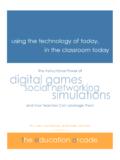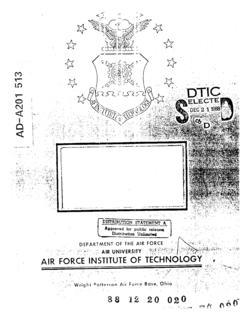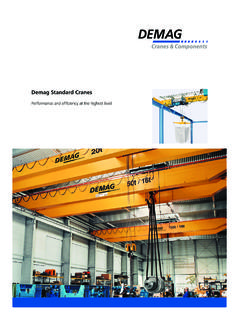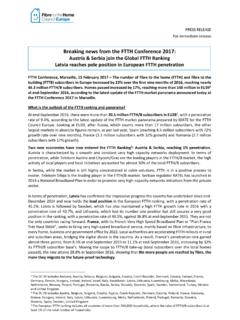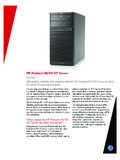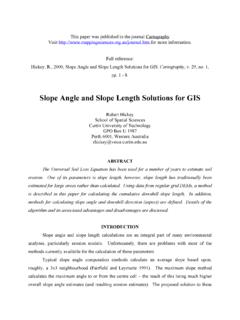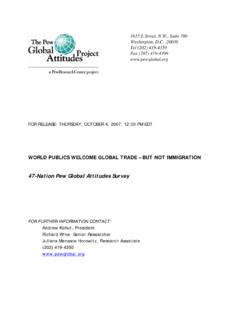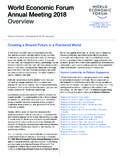Transcription of The 6-E Learning Model
1 November/December 2004 47 The E-search adds a modern component to the popular5-E Learning and techniques to enhance your science teachingost of us are familiar withthe 5-E Model of scienceinstruction Engage,The 6-E Learning ModelBy Debby A. Chessin and Virginia J. MooreExplore, Explain, Expand, andEvaluate (Trowbridge and Bybee1990). It is a valuable tool that al-lows us to structure science experi-ences so students use the processesof scientific inquiry to construct andconnect ideas rather than simplymemorize seemingly unrelatedfacts. I ve added a sixth E e-search which ties the five stagestogether and incorporates the use oftechnology into the Model . E-search encompasses any useof electronic media Internet re-search; spreadsheets and databases;programs such as Hyperstudio; CD-ROMs; e-mail; PowerPoint presen-tations; as well as tools such as dataloggers and digital cameras.
2 Theycan occur in the Learning Model atdifferent stages, depending on thenature of the activity, student inter-est, needs, and article describes first-gradestudents experiences as they inves-tigate properties of rocks through atypical Learning cycle but with e-search added to enhance their un-derstanding. A first-grade teacherand I developed and tested the ac-tivities with children as part of aneffort to show teachers that studentscan use basic science processes todevelop conceptual understandingof a topic in this case, the charac-teristics of Enhanced EngagementDuring the engage stage of theinstructional Model , activities aredesigned to stimulate thinking andaccess prior knowledge. An e-search can easily be embeddedinto this stage of the Model , suchas having students use the Internetto research uses of rocks and min-erals or view a CD-ROM that ex-plains the difference betweenrocks and our classroom, we engaged students using a K-W-L chart torecord our students prior knowl-edge and experiences with rocksand minerals.
3 It was exciting to lis-ten as many students assured us thatthey already knew that rocks were, very heavy, very hard, and48 Science and Children very dirty. Some said thatrocks have all kinds ofshapes and they are cool. Students were anxious toshare their personal experiencesas well: If you put a rock in arock polisher, you can do coolthings, and they get shiny; I vebeen collecting rocks; I have around rock and it has lines on it; and one student reported, well,my daddy found one and an In-dian made it into an arrow. From this discussion, welearned that several studentshad rock collections that theymight like to share, and be-cause one child s father col-lected arrowheads, the stu-dents e-mailed him (ane-search) to invite him to this direct connec-tion, students could conductan e-mail interview with a ge-ologist as an with TechnologyIn the explore stage of an investiga-tion, students conduct hands-onwork and think, plan, investigate, anddiscuss alternatives with others.
4 Theteacher acts as a facilitator and en-courages students to work togetherwithout direct instruction. Questionsare intended to focus students think-ing on their observations and descrip-tions of their explorations. In thisstage of the Learning cycle, specificprobing questions help redirect stu-dents investigations as needed with-out giving away e-search in the explore phase might typically involve visit-ing teacher-determined Internetsites, viewing CD-ROMs to collectinformation to answer open-endedquestions as they test and refinepredictions and hypotheses. Or, if itis appropriate for the topic beingstudied, students may use data-bases and spreadsheets to collectand organize the first-grade rock study, eachpair of students chose several rockspecimens and received two handlenses so that they could work indi-vidually and then talk about an e-search, students then pho-tographed their favorite specimen witha digital camera, and wrote descriptivewords about their rock, which theythen shared with their photos were later used in exten-sion and evaluation addition to the use of the digitalcamera, for another e-search compo-nent, pairs of students tookturns using the class s computerto research the topic of rocksand minerals on the Internet(see Internet Resources).
5 Through their research,students learned that rocksare made of different mineralsand that rocks can be classi-fied and identified based ondifferent tests. They were sur-prised to see the work they didin the classroom was similarto what geologists do in thereal world!Explanationsand ReflectionsIn the explanation stage, stu-dents are involved in analysisand clarification of their explo-ration. Students identify pat-terns, relationships, compari-sons, and contrasts and mayrefer to their graphs, drawings,databases, spreadsheets, or digitalimages to help them clarify theirideas. The teacher formally providesdefinitions and explanations, usingthe students prior knowledge and ex-perience as the basis for the rock study, after observingcharacteristics of their specimenswith their senses, the students toldus what they learned and quicklypicked up on the correct terminol-ogy for characteristics of said that they could sorttheir rocks based on texture (roughor smooth), density (sink or float),color (black, red, yellow, or white),and luster (shiny or not shiny).
6 The e-search part of the lessonincluded videotaping the studentsworking, sharing, and discussingtheir ideas. Students took turns vid-November/December 2004 49eotaping other groups to documentthe Learning taking place. When weshowed it to the students the nextday, they were delighted to relive theexcitement of Learning . We used therecorded interactions to provide ameans of reflection for the Through E-searchIn the elaboration or extension stage, students solidify their con-ceptual understanding and apply itto a new and relevant situation. Inthis stage, the teacher will expectstudents to use correct scientific ter-minology and students worked in groups offour and used at least 10 specimens toplay Guess My Rule. They sortedtheir rocks into two groups with andwithout a chosen characteristic.
7 Asother groups tried to guess the sortingcharacteristic, we circulated andasked students to justify their ideas: How do you or Explainhow you This observa-tion and classification gamestretched their communication skillsas they justified their choices to eachother. As an e-search, students thenused the computer to create a set ofcards, each with an inserted digitalimage of the specimen and a descrip-tion of its properties in correct scien-tific terms. The cards were lami-nated for appropriate e-search sug-gestions for this Learning phase areto research related websites for ex-tension ideas or use e-mail to com-municate with students from otherschools or regions or with scientistsin the with an E-searchThe evaluation stage is the time forteacher, self-, and teacher should continue to askopen-ended questions, such as What evidence do you have to sup-port your idea, or How would Teachers may use tradi-tional means, such as pencil-andpaper tests or individual and groupobservation checklists, along withother performance evaluations.
8 We used a rubric that assessedboth process skills and conceptualunderstanding. We found that ourstudents had learned a great dealabout observing and classifying theirrock and mineral specimens andabout using the correct terminologyto describe and write about we did not incorporatean e-search in our evaluation phase,students could create a PowerPointpresentation as a final e-search todemonstrate their new understand-ing and skills. Slides could includedigital images and text to illustratethe items included in the tothe StandardsThis article relates to the follow-ing National Science EducationStandards (NRC 1996):Teaching StandardsStandard B:Standard B:Standard B:Standard B:Standard B:Teachers of science guide andfacilitate StandardsStandard C:Standard C:Standard C:Standard C:Standard C:Assessment tasks must be au-thentic and students must haveadequate opportunity to dem-onstrate their achievements.
9 E is for ExcellenceAs the rock study showed, the tech-nology-enhanced experiences of the6-E Model provided another layerupon which students can build fur-ther conceptual understandingwhen they revisit the topic of geologyin later grades. In addition, the tech-nology experiences helped studentsdevelop their skills of observation,classification, communication, andtechnical e-searches incorporated intothis unit didn t replace the hands-on, minds-on Learning experiencesbut accentuated them they taughtstudents valuable skills and pro-vided multiple opportunities to ex-tend the A. Chessin is an assistant professorof elementary education at The Uni-versity of Mississippi in University,Mississippi. Virginia J. Moore is afirst-grade teacher at Lafayette Ele-mentary School in Oxford, Research Council (NRC).
10 1996. National Science EducationStandards. Washington, : Na-tional Academy , , and Becoming a Secondary ScienceTeacher. Columbus, Ohio: and Minerals for Kids
